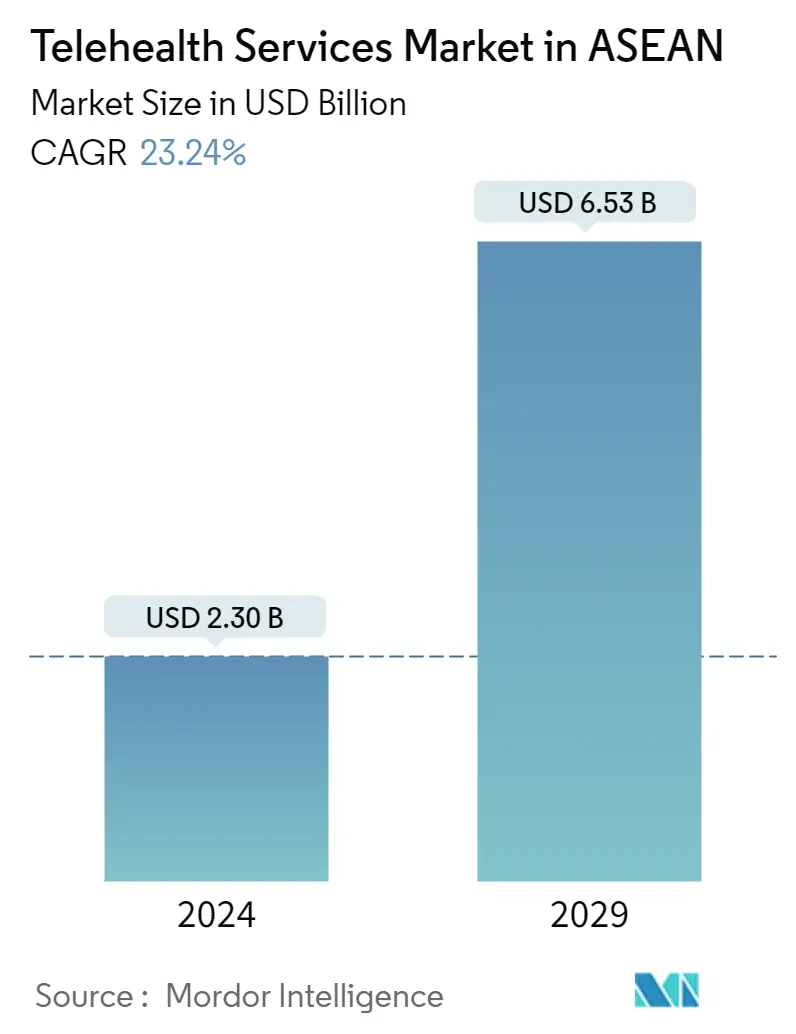Market Size of Telehealth Services Industry in ASEAN

| Study Period | 2020 - 2029 |
| Base Year For Estimation | 2023 |
| Market Size (2024) | USD 2.30 Billion |
| Market Size (2029) | USD 6.53 Billion |
| CAGR (2024 - 2029) | 23.24 % |
| Market Concentration | Medium |
Major Players
*Disclaimer: Major Players sorted in no particular order |
ASEAN Telehealth Service Market Analysis
The Telehealth Services Market in ASEAN Industry is expected to grow from USD 2.30 billion in 2024 to USD 6.53 billion by 2029, at a CAGR of 23.24% during the forecast period (2024-2029).
Telehealth is the delivery of healthcare services using technology in the diagnosis, treatment, and prevention of disease or injuries, research, evaluation, and education for healthcare providers and their communities.
In the current ASEAN market, The Telehealth Service Market is anticipated to witness a proliferation in the coming years backed by an increase in the biotechnology industry in the country. The rapid urbanization in the country is leading to an increased demand for best-in-class infrastructure in the residential domain along with a rise in the demand for premium infrastructural Types. The increase in the healthcare costs, a spur in the technological innovations in the healthcare sector, and efforts to find a resolution to address the accessibility issues of the healthcare sector in remote areas which have been a perennial problem in the developing economies across the countries are expected to ramp up double-digit growth prospects for the ASEAN telehealth market in the coming timeframe and offer bountiful opportunities to the potential industrial makers of the product and the to-be-investors to register significant growth in the coming timeframe.
It's common to find a few competing telehealth platforms in one country, as some platforms have started serving in Telehealth Services Market along with their primary business industry. The use of mHealth in ASEAN countries has increased exponentially in the last decade as it is one of the fastest-growing markets for the digital economy. The diversity in telehealth and telemedicine practice across countries calls for uniformity in guidelines and standards. Payers, regulators, and policymakers have been referring to guidelines and legislations, especially if telemedicine were integrated into existing policies and standard care. The telehealth guidelines in ASEAN, as the region shares common social and economic conditions, are having a very progressive impact on the region's Telehealth Service Market. Advances in digital technology have expanded mobile health (mHealth) applicability from providing health care in remote communities.
The COVID-19 pandemic further underscores the need for digital health services in ASEAN. Given the spread of the pandemic and the largescale lockdown measures imposed by governments in response, digital health services helped alleviate the pressure on medical resources and minimize the amount of persontoperson contact that is required for treatment. Initiatives were made by the Indonesian, Malaysian, and Philippine governments to foster the use of telemedicine amid the pandemic. The COVID-19 pandemic has spurred the growth of telemedicine from telephone consultations to a spectrum of ICT applications. The diversity in telemedicine practice across countries calls for uniformity in guidelines and standards
ASEAN Telehealth Service Industry Segmentation
The Telehealth Services Market in ASEAN is one of the growing and highly demanded Telehealth Services Market as people are more preferring the contactless health prescription and innovative platforms for which Telehealth Services are found much more efficient.
A complete background analysis of the Telehealth Services Market in ASEAN, which includes an assessment of the economy, market overview, market size estimation for key segments, emerging trends in the market, market dynamics, and key company profiles is covered in the report.
The Telehealth Services Market in ASEAN is Segmented By Service Type (Remote Patient Monitoring, Real Time Interactions, Store and Forward), By Type (e-Consultation, Online Appointment Booking, Telemedicine, Diagnostics, and Fitness Monitors), By Mode of Delivery (Web-Based, Cloud-Based, and On-Premises), By End User (Providers, Players, and Patients), and By Geography (Indonesia, Singapore, Vietnam, Thailand and Rest of ASEAN).
| By Service Type | |
| Remote Patient Monitoring | |
| Real time interactions | |
| Store and Forward | |
| Other Services |
| By Mode of Delivery | |
| Web-Based | |
| Cloud-Based | |
| On-Premises |
| By Types | |
| e-Consultation | |
| Online Appointment Booking | |
| Telemedicines | |
| Diagnostics and Fitness Monitors |
| By End User | |
| Providers | |
| Players | |
| Patients | |
| Others |
| By Geography | |
| Singapore | |
| Indonesia | |
| Vietnam | |
| Thailand | |
| Rest of ASEAN |
Telehealth Services Market in ASEAN Size Summary
The Telehealth Services Market in ASEAN is poised for significant expansion, driven by advancements in digital technology and the increasing demand for accessible healthcare solutions. The integration of telehealth services, which utilize technology for healthcare delivery, is gaining momentum across the region. This growth is supported by the burgeoning biotechnology sector, rapid urbanization, and the need for improved healthcare infrastructure. The market is further bolstered by the rising healthcare costs and technological innovations aimed at overcoming accessibility challenges in remote areas. The COVID-19 pandemic has accelerated the adoption of telehealth, highlighting its role in alleviating pressure on medical resources and minimizing person-to-person contact. This has led to increased government initiatives in countries like Indonesia, Malaysia, and the Philippines to promote telemedicine, thereby enhancing the market's growth prospects.
The ASEAN telehealth market is characterized by a competitive landscape with numerous players, including startups and established companies, collaborating with international partners to enhance their service offerings. Countries such as Vietnam are making significant strides in healthcare digitalization, with public hospitals outsourcing to local IT companies to develop digital solutions. The market's growth is also fueled by the increasing adoption of telemedicine platforms by healthcare practitioners, aimed at reducing hospital admissions and improving workflow. Despite challenges like high out-of-pocket expenses in some countries, the market continues to thrive, with key players like DoctorAnywhere, Halodoc, and Viettel leading the charge. Partnerships, such as the one between Vonage and Doctor Anywhere, are further strengthening the market by providing innovative digital healthcare solutions across Southeast Asia.
Telehealth Services Market in ASEAN Market Size - Table of Contents
-
1. MARKET DYNAMICS
-
1.1 Market Overview
-
1.2 Market Drivers
-
1.3 Market Restraints
-
1.4 Insights on Various Regulatory Trends Shaping Telehealth Services Market in ASEAN
-
1.5 Insights on impact of technology and innovation in Telehealth Services
-
1.6 Insights on Performance of Telehealth Services in ASEAN
-
1.7 Industry Attractiveness - Porters' Five Forces Analysis
-
1.7.1 Threat of New Entrants
-
1.7.2 Bargaining Power of Buyers
-
1.7.3 Bargaining Power of Suppliers
-
1.7.4 Threat of Substitutes
-
1.7.5 Intensity of Competitive Rivalry
-
-
1.8 Impact of COVID-19 on the Market
-
-
2. MARKET SEGMENTATION
-
2.1 By Service Type
-
2.1.1 Remote Patient Monitoring
-
2.1.2 Real time interactions
-
2.1.3 Store and Forward
-
2.1.4 Other Services
-
-
2.2 By Mode of Delivery
-
2.2.1 Web-Based
-
2.2.2 Cloud-Based
-
2.2.3 On-Premises
-
-
2.3 By Types
-
2.3.1 e-Consultation
-
2.3.2 Online Appointment Booking
-
2.3.3 Telemedicines
-
2.3.4 Diagnostics and Fitness Monitors
-
-
2.4 By End User
-
2.4.1 Providers
-
2.4.2 Players
-
2.4.3 Patients
-
2.4.4 Others
-
-
2.5 By Geography
-
2.5.1 Singapore
-
2.5.2 Indonesia
-
2.5.3 Vietnam
-
2.5.4 Thailand
-
2.5.5 Rest of ASEAN
-
-
Telehealth Services Market in ASEAN Market Size FAQs
How big is the ASEAN Telehealth Services Market?
The ASEAN Telehealth Services Market size is expected to reach USD 2.30 billion in 2024 and grow at a CAGR of 23.24% to reach USD 6.53 billion by 2029.
What is the current ASEAN Telehealth Services Market size?
In 2024, the ASEAN Telehealth Services Market size is expected to reach USD 2.30 billion.

